
-----
Filiform corrosion on steel
January 26, 2011
Q. Hello there again.
Would anyone with experience of what looks like to me filiform corrosion (new to me but the Web has pointed me at some info) care to suggest the likelihood of corrosion appearing under the lacquer of some steel shelving items supplied from China. (photo)
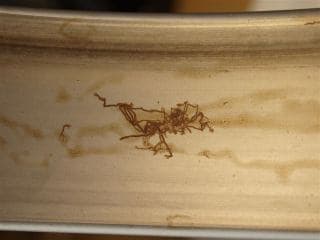
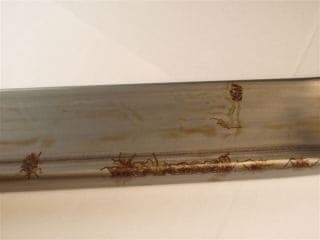
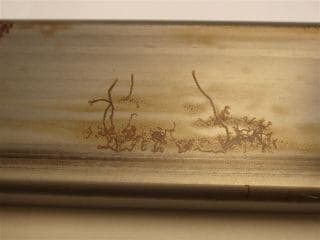
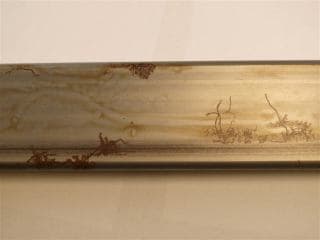
I understand from published data that migration of oxygen and water through the lacquer can occur in high humidity conditions; really? The lacquer doesn't look disrupted at all, and has only lifted the lacquer in a few places, mostly no raising can be felt in areas of the fine filaments.(photo)
Some of the other areas exhibit slight but widespread discolouration.
The components are giving highish levels of zinc and phosphorous by SEM so I presume the items were zinc phosphated before lacquering.
How would the Zn Phos treatment have taken place? Wet?
I expect the corrosion could have been caused by moisture on the surfaces from improper treatment/drying or handling etc. Or by migration as discussed.
Is this common, or widespread on similar items?
Interesting eh?
Best regards from Blighty.
Martin Rich
Metallurgist - Plymouth United Kingdom
Q. Further information on this; as the photos show, some of the corrosion patches seem to have initiated at fairly widespread darker areas of brown staining so I'm thinking this tends to suggest that it may have been the result of moisture being already present on the surface before lacquer coating. But this doesn't prove that or discount migration through the coating.
The coating is approx. 75 micron, (3 thou), and well adhered with no obvious disruptions.
Thanks
- Plymouth, United Kingdom
January 27, 2011
Based on your description, I would say that filiform corrosion is more likely than excessive moisture being present prior to application of the lacquer. My reasoning is that if the coating does not show any defects (loose paint, holidays, chips, bubbles, contamination, fisheyes, etc.), then it is unlikely that moisture was present before painting, because these are the types of defects that otherwise would be seen. Have you sectioned through any of the affected areas? I would look at this, as well as investigate whether or not the lacquer has been fully cured/cross-linked, which will affect it's resistance to water.
Toby PadfieldAutomotive component & module supplier - Michigan, USA
January 31, 2011
February 3, 2011
It looks like the corrosion my be caused by inadequate rinsing and salts from the rinsewater that dried on the steel before the lacquer was applied.
Lyle Kirman
consultant - Cleveland Heights, Ohio
February 3, 2011
Q. OK thanks Toby and Lyle.
If you look at the top left photo, there's a clear patch of corrosion initiating at an area of wash like brown discolouration which is actually comprised of fine spots of rust, and then with filaments starting out from the darkest area of corrosion.
I'm still unclear about the Zn and P; in a cross-section there's a 2 to 3 microns metallic looking layer giving Zn, P and O by SEM; the presence of the Zn and P have clearly not held up the filaments which have gaily (can I say that?) tracked across the layer without being impeded.
Also is this type of corrosion common?
And is it likely to have stopped? And might it continue?
Best Regards
Martin
|
Ted - Does anyone know how Freeman N is? The site is lessened without his input, let alone his wit and humour. Martin Rich- Plymouth UK Hi, Martin. We have a note on the front page of the site from Freeman. Sadly, his prognosis is not good. Yes, I am profoundly grateful every day for Freeman's contributions to the site. And for yours, and those of the many other "regulars" whose input has made finishing.com useful to readers. If it was just me answering questions, the site would have died years ago; instead, with everyone's help, I have the world's best job :-) Regards,  Ted Mooney, P.E. Striving to live Aloha finishing.com - Pine Beach, New Jersey Ted is available for instant help or longer-term assistance. February 3, 2011 Ed. note 2012: |
A. To answer some of your questions. Filiform corrosion happens when moisture, oxygen, and a salt, usually Cl- or SO4- are trapped under the film. The moisture and oxygen can, and likely did, migrate through the lacquer. You can expect the corrosion to continue unless the lacquer is removed, the surface cleaned, and the lacquer reapplied. In the future better lacquer (thicker and pore free) will help, but a perfectly clean surface is imperative.
http://www.corrosionclinic.com/types_of_corrosion/filiform_corrosion_underfilm_corrosion.htm

Jeffrey Holmes, CEF
Spartanburg, South Carolina
Rust Tunnels under Paint?
December 27, 2017Q. Hello Finishers,
I have sometimes noticed "tunnels" of rust forming under paint on steel; they can look "snake-like" or they can be straight, and are about the thickness of a human hair.
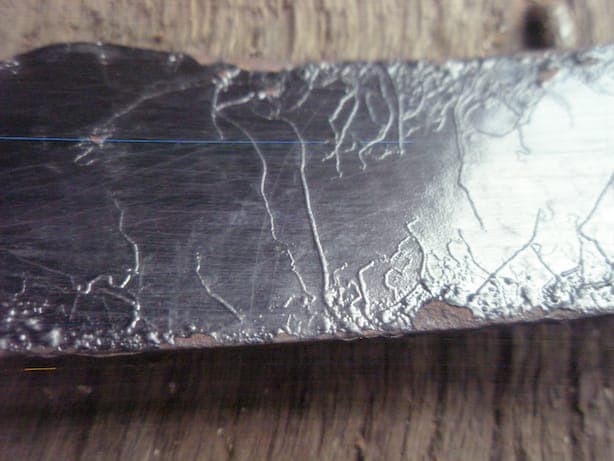
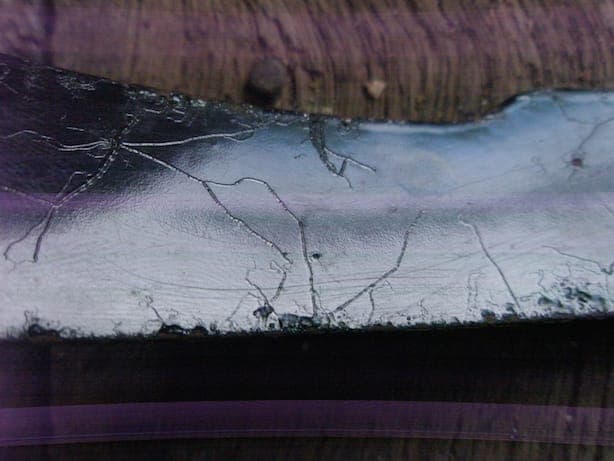
What causes such a phenomena? People from Europe or America may be familiar with the tunnelling of moles, which push dirt up on to the surface of the ground, above the tunnel they are making, as they go along, and these "rust tunnels" remind me of that. As the rust is forming, it pushes the paint up, as it moves along on a narrow path. Where is it going and why does it only rust in that narrow hair-width shape.
Kind regards,
Hobbyist - Coffs Harbour, NSW, Australia
A. Hi Chris. It's called filiform corrosion (a special case of crevice corrosion), and with that search term you should be able to find all about it. It's probably evidence that the steel wasn't properly cleaned and phosphatized before painting. Proper cleaning and phosphatizing is quite effective at reducing filiform corrosion; coatings which are thin are a common cause, but that doesn't look applicable to me here. Good luck.
Regards,

Ted Mooney, P.E. RET
Striving to live Aloha
finishing.com - Pine Beach, New Jersey
Ted is available for instant help
or longer-term assistance.
January 2018
Q. Thank you Ted for naming this phenomena as "Filiform Corrosion"; I could find nothing by searching for "Rust Tunnels", and thought I was the first person to ever observe this phenomena!
Nonetheless, I have not found out why they sometimes go straight and why they curve; probably some physical/chemical explanation. Part of me thinks that there may be some mystical/metaphysical reason why they go where they go, and perhaps they are trying to tell us something, but I'm not taking that part of me very seriously.
Cheers,
- Coffs Harbour, NSW, Australia
January 9, 2018
Q, A, or Comment on THIS thread -or- Start a NEW Thread
